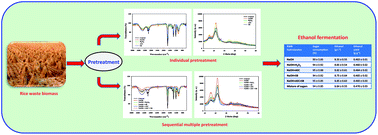Improving alkaline pretreatment method for preparation of whole rice waste biomass feedstock and bioethanol production†
Abstract
Efficient conversion of fermentable sugars from cheap lignocellulosic biomass is currently needed for viable ethanol production technology. This study investigates the efficiency of individual and multiple chemical pretreatment for the saccharification of whole rice waste biomass (RWB). Individual alkaline pretreatment combined with autoclaving provided a maximum yield of 505 mg of reducing sugar with 69.2% hydrolysis yield after two-step enzymatic hydrolysis using 20 filter paperase (FPU) g−1 of RWB. Sequential pretreatment of acidified sodium chlorite and sodium bicarbonate to alkaline pretreated RWB resulted in maximum yield of 725 mg of reducing sugar with hydrolysis yield of 90.6% using a lower enzyme dose (10 FPU g−1 of RWB), indicating the feasibility of the process. The effects of different pretreatments on chemical composition and structural complexity of whole RWB and its relation with saccharification were investigated using various analytical techniques. Finally, the enzymatic hydrolysates of pretreated RWB were found suitable for ethanol production. The maximum sugar consumption and ethanol yield by Saccharomyces cerevisiae SR8 were 95% and 0.465 g g−1 of sugar, respectively. The developed sequential pretreatment showed significant delignification and saccharification of whole RWB at low enzyme dosage. Also efficient conversion of the hydrolysate to ethanol without detoxification demonstrated the feasibility of the process.


 Please wait while we load your content...
Please wait while we load your content...